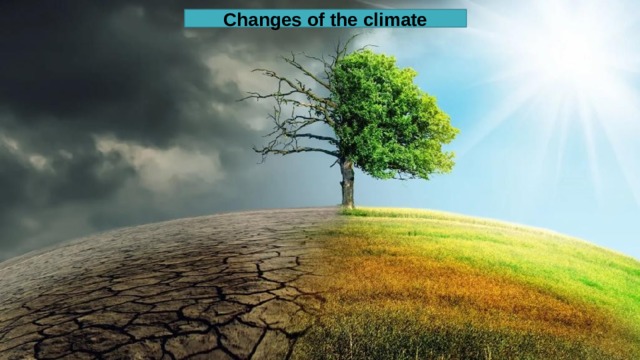
Changes of the climate

In recent years, the climate on Earth has changed markedly: some countries suffer from abnormal heat, others from too harsh and snowy winters, unusual for these places.
Environmentalists talk about global climate change, including an increase in the average annual temperature,
causing the melting of glaciers, and rising sea levels.
In addition to warming, there is also an imbalance in all natural systems, which leads to changes in precipitation patterns, temperature anomalies, and an increase in the frequency of extreme events such as hurricanes,
floods, and droughts.
According to scientists, for ten months of 2015, the average temperature of the planet was 1.02 °C higher than that recorded in the XIX century (when the observation of changes in global temperature began).
The threshold of one degree was exceeded for the first time in modern history. Scientists agree that it is human activity-the burning of oil, gas and coal-that leads to the greenhouse effect, which causes an increase in average temperature.
Experts note that the period between 2000 and 2010 saw the most powerful increase in greenhouse gas emissions
in the last 30 years. According to the World Meteorological Organization, their concentration in the atmosphere reached a record high in 2014.

What is the threat of climate warming
If countries do not start to seriously address the problem of environmental protection,
by 2100, the temperature
on the planet may rise by 3.7-4.8 °C.
Climatologists warn : irreversible consequences for the environment will come already with warming of more
than 2 °C.
In order to draw maximum attention to climate issues, the UN has attracted not only politicians and scientists, but also
celebrities to the discussion.
Hollywood actor Robert Redford warned
in a statement that the international community "has ended the time
of half-measures and denial of the problem
of climate change”

Natural disasters
Climate zones will shift, weather changes will become more abrupt (severe frosts, followed
by sudden thaws in winter, an increase in the number of abnormally hot days in summer).
The frequency and intensity of abnormal events, such as droughts and floods, will increase.
The link between climate change and the occurrence of natural disasters was proved
by American scientists who found traces
of warming when studying tropical cyclones
in the Pacific Ocean, unusually high summer temperatures in Europe, China, South Korea
and Argentina, as well as forest fires
in the US state of California. Climate change
has also been a catalyst for droughts in Africa
and the Middle East, snowstorms in Nepal,
and torrential downpours that have caused flooding in Canada and New Zealand.

Uninhabitable territories
Some countries may become uninhabitable
by 2100 due to increased humidity and high average temperatures.
According to a study by American scientists, Qatar, Saudi Arabia, Bahrain,
the United Arab Emirates
and other countries in the Middle East
are at risk. According to the calculations
of climate scientists, at the current rate
of growth of greenhouse gas emissions
by 2070, the average air temperature
in the Persian Gulf countries
can reach 74-77 °C.
This will make the territories unsuitable
for people. The exception may be large megacities with a developed
air conditioning system.
But even in them, people will be able to leave the house only at night.
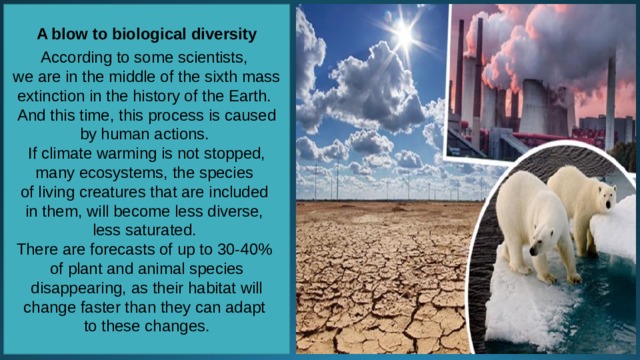
A blow to biological diversity
According to some scientists,
we are in the middle of the sixth mass extinction in the history of the Earth.
And this time, this process is caused by human actions.
If climate warming is not stopped, many ecosystems, the species
of living creatures that are included
in them, will become less diverse,
less saturated.
There are forecasts of up to 30-40%
of plant and animal species disappearing, as their habitat will change faster than they can adapt
to these changes.
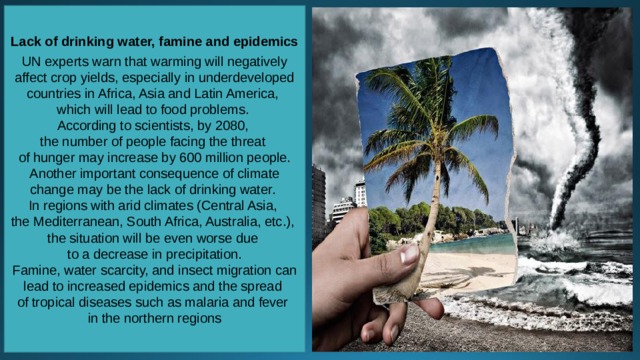
Lack of drinking water, famine and epidemics
UN experts warn that warming will negatively affect crop yields, especially in underdeveloped countries in Africa, Asia and Latin America,
which will lead to food problems.
According to scientists, by 2080,
the number of people facing the threat
of hunger may increase by 600 million people.
Another important consequence of climate change may be the lack of drinking water.
In regions with arid climates (Central Asia,
the Mediterranean, South Africa, Australia, etc.),
the situation will be even worse due
to a decrease in precipitation.
Famine, water scarcity, and insect migration can lead to increased epidemics and the spread
of tropical diseases such as malaria and fever
in the northern regions
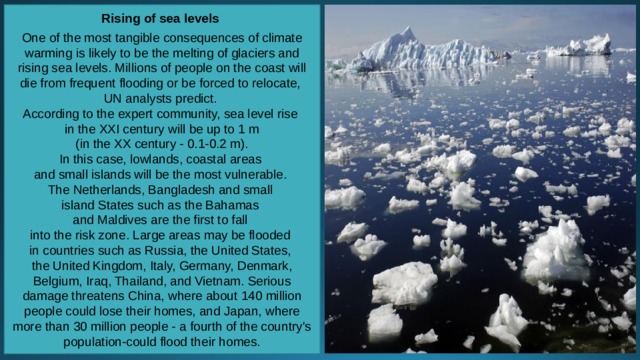
Rising of sea levels
One of the most tangible consequences of climate warming is likely to be the melting of glaciers and rising sea levels. Millions of people on the coast will die from frequent flooding or be forced to relocate,
UN analysts predict.
According to the expert community, sea level rise
in the XXI century will be up to 1 m
(in the XX century - 0.1-0.2 m).
In this case, lowlands, coastal areas
and small islands will be the most vulnerable.
The Netherlands, Bangladesh and small
island States such as the Bahamas
and Maldives are the first to fall
into the risk zone. Large areas may be flooded
in countries such as Russia, the United States,
the United Kingdom, Italy, Germany, Denmark, Belgium, Iraq, Thailand, and Vietnam. Serious damage threatens China, where about 140 million people could lose their homes, and Japan, where more than 30 million people - a fourth of the country's population-could flood their homes.
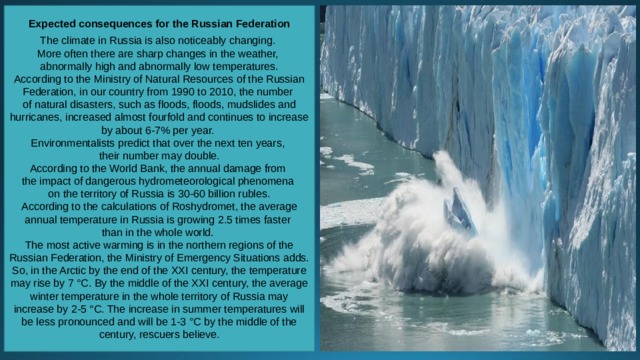
Expected consequences for the Russian Federation
The climate in Russia is also noticeably changing.
More often there are sharp changes in the weather,
abnormally high and abnormally low temperatures.
According to the Ministry of Natural Resources of the Russian Federation, in our country from 1990 to 2010, the number
of natural disasters, such as floods, floods, mudslides and hurricanes, increased almost fourfold and continues to increase
by about 6-7% per year.
Environmentalists predict that over the next ten years,
their number may double.
According to the World Bank, the annual damage from
the impact of dangerous hydrometeorological phenomena
on the territory of Russia is 30-60 billion rubles.
According to the calculations of Roshydromet, the average annual temperature in Russia is growing 2.5 times faster
than in the whole world.
The most active warming is in the northern regions of the Russian Federation, the Ministry of Emergency Situations adds.
So, in the Arctic by the end of the XXI century, the temperature may rise by 7 °C. By the middle of the XXI century, the average winter temperature in the whole territory of Russia may increase by 2-5 °C. The increase in summer temperatures will be less pronounced and will be 1-3 °C by the middle of the century, rescuers believe.
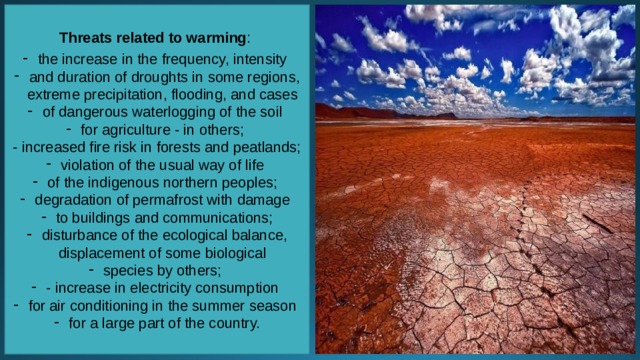
Threats related to warming :
- the increase in the frequency, intensity
- and duration of droughts in some regions, extreme precipitation, flooding, and cases
- of dangerous waterlogging of the soil
- for agriculture - in others;
- increased fire risk in forests and peatlands;
- violation of the usual way of life
- of the indigenous northern peoples;
- degradation of permafrost with damage
- to buildings and communications;
- disturbance of the ecological balance, displacement of some biological
- species by others;
- - increase in electricity consumption
- for air conditioning in the summer season
- for a large part of the country.
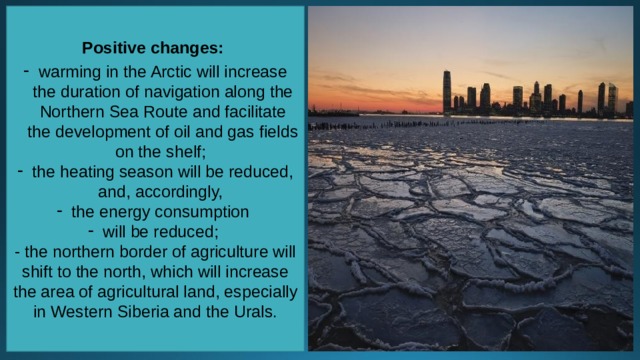
Positive changes:
- warming in the Arctic will increase the duration of navigation along the Northern Sea Route and facilitate the development of oil and gas fields on the shelf;
- the heating season will be reduced, and, accordingly,
- the energy consumption
- will be reduced;
- the northern border of agriculture will shift to the north, which will increase the area of agricultural land, especially in Western Siberia and the Urals.

What to do
According to scientists,
it is unlikely that humanity
will be able to completely prevent climate change.
However, the international community is able to contain the increase
in temperature in order
to avoid irreversible environmental consequences.
To do this, it is necessary to limit greenhouse gas emissions, develop alternative energy and develop
a strategy to reduce the risks
due to warming.

Adapting the life of society to new conditions
Plans to minimize the damage caused by climate change should cover all areas of human activity, including health, agriculture and infrastructure.
In Russia, for example, you need to change the storm sewer system, prepare for storm winds (recalculate the strength of structures), change the fire extinguishing system - droughts increase the fire danger.
In Kyrgyzstan, the snow border in the Tien Shan has risen, this has caused problems with grazing - it is necessary to take measures to preserve pastures.
However, different States have different opportunities to offset the impact of climate change.
So, for example, the Netherlands and Bangladesh are experiencing the same problems: there are more storms,
the sea level has risen.
But Holland already has a plan of action, they know how they will strengthen the dams, where they will get the funds.
And in Bangladesh, there is none of this, with 10 times the coastline and 10 times the population, and 100 million people living in dangerous areas who will need
to be relocated somewhere.
Thus, most of the measures needed for adaptation are quite simple and clear, but they require funds
and effective planning to implement them.

Reducing greenhouse gas emissions
According to climate scientists, to keep the temperature rise in the range of up to 2 °C, countries need to reduce global emissions
by half by 2050 compared to the level of 1990, and by the end of the XXI century –
to reduce to zero.
According to PwC analysts, since 2000,
Russia has on average reduced carbon dioxide emissions by 3.6% per year, the United Kingdom-by 3.3%, France-by 2.7%,
the United States-by 2.3%.
The average annual reduction in carbon emissions over the past 15 years was 1.3%.
However, these efforts are not enough.
To prevent irreversible climate change, the annual reduction in carbon dioxide emissions until 2100 should be at least 6.3%.
This means, on the one hand, it is necessary
to introduce energy - saving technologies, on the other-to switch to alternative energy sources.

The sun or the atom
Several sources of energy are safe
for the atmosphere in terms of emissions: hydropower, nuclear power plants, and new renewable sources-solar, wind, and tides. Hydroelectric power has visible physical limits
(there are not many rivers on Earth), wind and tides can only be used locally, so the main sources
of energy of the future are the Sun and the atom.
According to the expert, based on the current level of technology development, nuclear energy looks more solid: the share of alternative renewable energy sources now accounts for 2% of global consumption, and the atom already provides 16%
of the world's electricity
(in developed countries - more than 70%,
in the north-west of Russia - 40%).
The advantage of nuclear power is that it is
a large-scale energy industry, it is a power plant
for large industrial agglomerations, large cities.
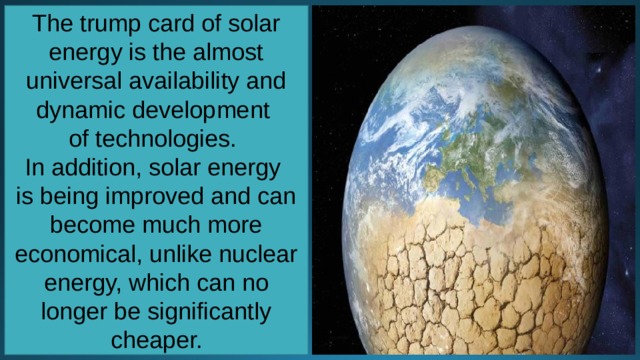
The trump card of solar energy is the almost universal availability and dynamic development
of technologies.
In addition, solar energy
is being improved and can become much more economical, unlike nuclear energy, which can no longer be significantly cheaper.
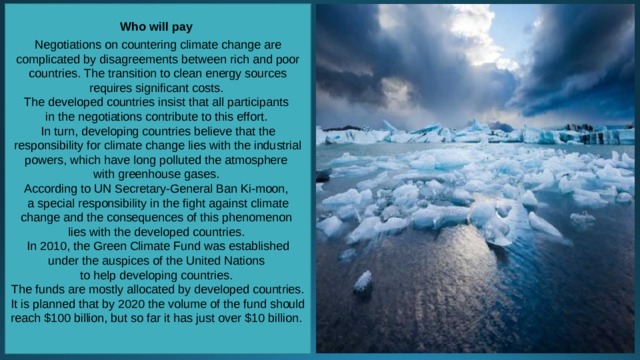
Who will pay
Negotiations on countering climate change are complicated by disagreements between rich and poor countries. The transition to clean energy sources requires significant costs.
The developed countries insist that all participants
in the negotiations contribute to this effort.
In turn, developing countries believe that the responsibility for climate change lies with the industrial powers, which have long polluted the atmosphere
with greenhouse gases.
According to UN Secretary-General Ban Ki-moon,
a special responsibility in the fight against climate change and the consequences of this phenomenon
lies with the developed countries.
In 2010, the Green Climate Fund was established under the auspices of the United Nations
to help developing countries.
The funds are mostly allocated by developed countries. It is planned that by 2020 the volume of the fund should reach $100 billion, but so far it has just over $10 billion.

Now the developed countries are experiencing a serious burden on state budgets, so they prefer that climate financing goes through private investment
or loans and borrowings.
Vulnerable countries are not ready to take out loans. Despite the fact that Russia has no obligations to contribute to the "Green Climate Fund", Moscow is ready
to support it on a voluntary basis.
First of all, this applies
to the CIS countries.
In November 2015, the fund approved the allocation of $168 million for the first eight projects to help developing countries adapt to the negative effects
of climate change.










































